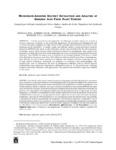Use este identificador para citar ou linkar para este item:
http://www.alice.cnptia.embrapa.br/alice/handle/doc/697142| Título: | Microwave-assisted solvent extraction and analysis of shikimic acid from plant tissues. |
| Autoria: | MATALLO, M. B.  ALMEIDA, S. D. B.   CERDEIRA, A. L.   FRANCO, D. A. S.   BLANCO, F. M. G.   MENEZES, P. T. C.   LUCHINI, L. C.   MOURA, M. A.   DUKE, S. O.   |
| Afiliação: | M. B. MATALLO, Weed Science Laboratory, Biological Institute, IB S. D. B. ALMEIDA, Weed Science Laboratory, Biological Institute, IB ANTONIO LUIZ CERDEIRA, CNPMA D. A. S. FRANCO, Weed Science Laboratory, Biological Institute, IB F. M. G. BLANCO, Weed Science Laboratory, Biological Institute, IB P. T. C. MENEZES, Weed Science Laboratory, Biological Institute, IB L. C. LUCHINI, Agrochemicals Ecotoxicology Laboratory, Biological Institute, IB M. A. MOURA, Weed Science Laboratory, Biological Institute, IB S. O. DUKE, Natural Products Utilization Research Unit, USDA, ARS. |
| Ano de publicação: | 2009 |
| Referência: | Planta Daninha, Viçosa, v. 27, p. 987-994, 2009. Número Especial. |
| Conteúdo: | A better method for determination of shikimate in plant tissues is needed to monitor exposure of plants to the herbicide glyphosate [N-(phosphonomethyl)glycine] and to screen the plant kingdom for high levels of this valuable phytochemical precursor to the pharmaceutical oseltamivir. A simple, rapid, and efficient method using microwave-assisted extraction (MWAE) with water as the extraction solvent was developed for the determination of shikimic acid in plant tissues. High performance liquid chromatography was used for the separation of shikimic acid, and chromatographic data were acquired using photodiode array detection. This MWAE technique was successful in recovering shikimic acid from a series of fortified plant tissues at more than 90% efficiency with an interference-free chromatogram. This allowed the use of lower amounts of reagents and organic solvents, reducing the use of toxic and/or hazardous chemicals, as compared to currently used methodologies. The method was used to determine the level of endogenous shikimic acid in several species of Brachiaria and sugarcane (Saccharum officinarum) and on B. decumbens and soybean (Glycine max) after treatment with glyphosate. The method was sensitive, rapid and reliable in all cases. |
| Palavras-chave: | Glifosato |
| Tipo do material: | Artigo de periódico |
| Acesso: | openAccess |
| Aparece nas coleções: | Artigo em periódico indexado (CNPMA)  |
Arquivos associados a este item:
| Arquivo | Descrição | Tamanho | Formato | |
|---|---|---|---|---|
| 2009AP35.pdf | 198,22 kB | Adobe PDF |  Visualizar/Abrir |









